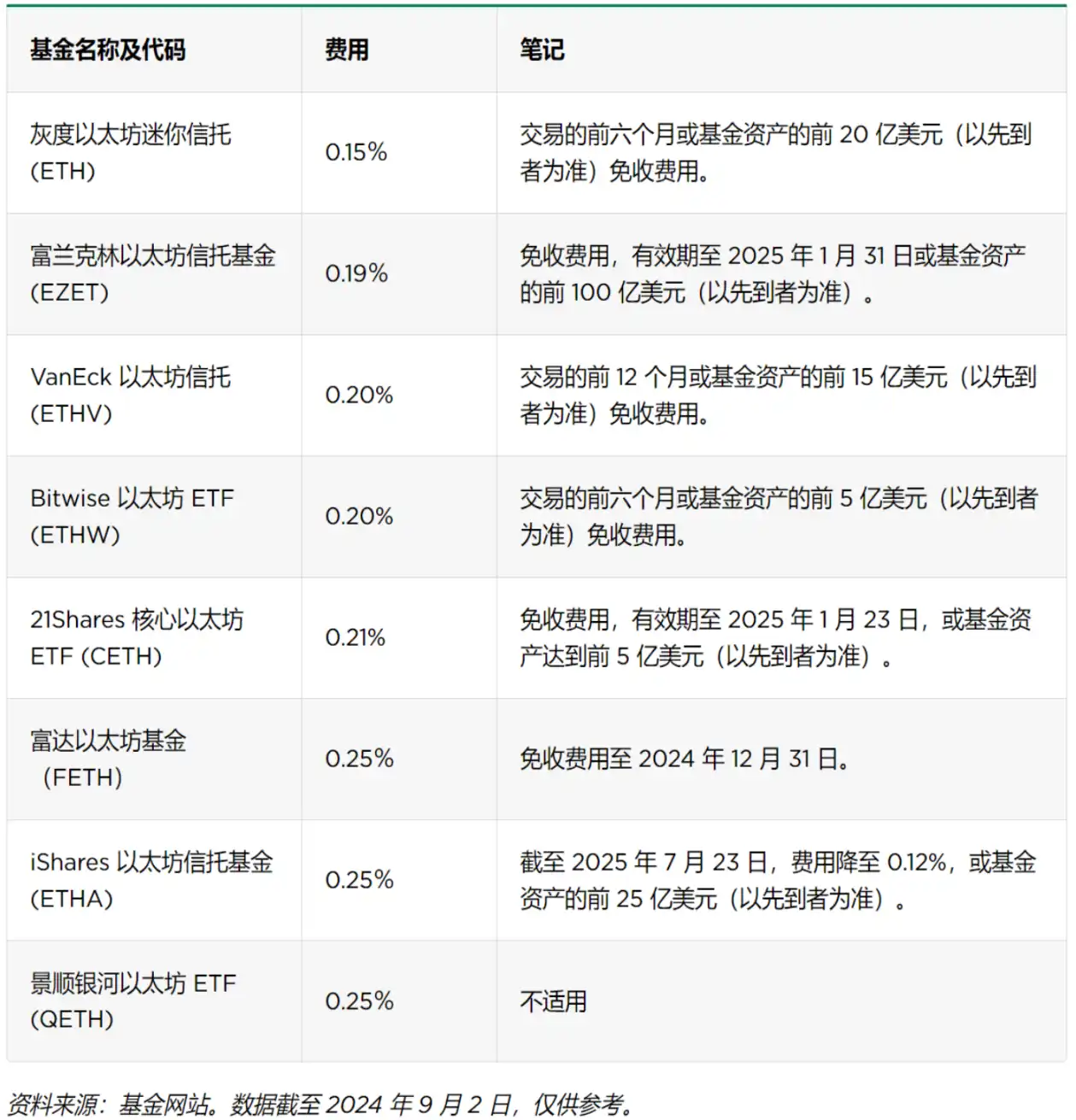Original title: 16 Ethereum ETFs and Their Fees, Promotions and Holdings
Original article by Sam Taube, Nerdwallet
Original translation: Vernacular Blockchain
About six months ago, the U.S. Securities and Exchange Commission (SEC) approved the first spot Bitcoin ETF. On July 23, 2024, the SEC approved the first spot Ethereum ETF to begin trading.
1. What is the spot Ethereum ETF?
The Spot Ethereum ETF is an exchange-traded fund that provides direct investment in Ethereum, the world’s second-largest cryptocurrency by market capitalization after Bitcoin.
Ethereum has many features that distinguish it from Bitcoin. Its blockchain not only carries Ether, but also hosts decentralized applications and non-fungible tokens (NFTs) that run on the Ethereum protocol. In addition, Ethereum now uses a Proof of Stake system to generate new coins, which is a more energy-efficient mechanism than the Proof of Work used in Bitcoin mining. (Ethereum also used a Proof of Work system before 2022, before switching to Proof of Stake.)
Before the spot ETF was approved, there were already Ethereum strategy ETFs on the market that indirectly tracked the price of Ether through futures contracts. However, such ETFs may not track the price of cryptocurrencies as accurately as spot Ethereum ETFs and may charge higher fees. The spot Ethereum ETF approved in July 2024 is the first of its kind.
2. Spot Ethereum ETF
As of now, eight different spot Ethereum ETFs have begun trading. Below is the name of each ETF and its trading symbol, as well as details on its fees and any promotional fee waivers.

3. No. 9 Ethereum Fund
Technically, there are currently nine investment funds on the market that track the spot price of Ethereum, but the ninth is not a traditional ETF. Grayscale Ethereum Trust (ETHE), not to be confused with its Mini Trust ETF, is an exchange-traded product (ETP) whose market price may deviate from its net asset value, potentially giving investors a premium or discount on their ether holdings.
ETHE is the world’s largest Ethereum spot fund, accounting for more than 2% of Ethereum’s total market cap at the time of writing. Its expense ratio is 2.50%, and there are currently no fee reduction promotions. It was also approved for trading on the exchange on July 23.
4. Ethereum ETF Price War
In the days leading up to the Ethereum ETF’s approval in July 2024, issuers have been engaged in a fee war. Many companies have filed multiple amended registration statements, lowering fees in an attempt to undercut their competitors. Some have followed suit, filing their own revisions within days, with even lower fees.
Others have offered last-minute promotions, such as announcing that fees would be waived for the first six months, to show that they were the cheapest Ethereum ETF on the market. This trend of rapid fee cuts and promotions continued until just days before the SEC’s approval announcement and is likely to continue in the future.
Given this, it’s worth double-checking any information you see about Ethereum ETF fees and promotions. Any numbers you see online are likely to be out of date by the time you read them.
5. Ethereum Strategy ETF
We define an Ethereum strategy ETF as any ETF that invests at least 50% of its assets in Ether futures. There are currently seven such funds on the market, and their fees are listed below in order from lowest to highest.

6. What does the approval of an ETF mean for Ethereum?
As of writing, the price of Ethereum has risen by more than 40% this year. It remains to be seen whether the recent ETF approval will further boost this rally.
Ethereum ETFs offer a new way for 401(k) and IRA investors to invest in cryptocurrencies. Americans hold nearly $40 trillion in retirement accounts, and many of these retirement accounts do not allow direct trading of cryptocurrencies. (Note: 401(k) and IRA are common retirement savings accounts in the United States. They generally do not allow direct purchases of cryptocurrencies, and Ethereum ETFs offer investors in these accounts a way to invest in cryptocurrencies indirectly.)
However, the market’s short-term reaction to the Ethereum ETF approval has been muted so far. On July 23 — the ETF’s first trading day — from 9:30 a.m. to 4:00 p.m. ET, the price of Ether actually fell slightly.
7. Ethereum ETF vs. Ethereum Itself
Spot Ethereum ETFs may have some advantages over other ways to invest in Ethereum. As mentioned earlier, for investors who cannot directly purchase Ethereum (such as retirement account investors), spot Ethereum ETFs may provide a cheaper and more reliable way to invest than previous Ethereum strategy ETFs.
However, it is worth noting that Ethereum ETFs also have some disadvantages compared to directly holding cryptocurrencies. Current Ethereum ETF investors will not receive staking rewards (i.e., a kind of interest or dividend reward for holding Ethereum).
If you want to gain access to this Ethereum functionality, you’ll need to invest directly in the cryptocurrency itself.

